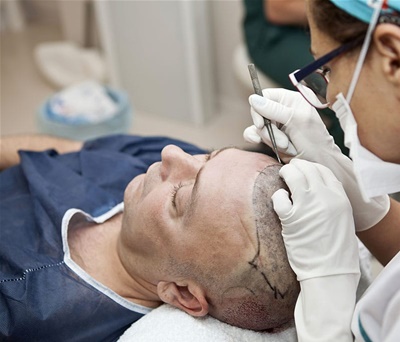
There are a lot of different options for people dealing with hair loss. The best hair loss solution for an individual depends on several factors, including the reason for the hair loss and how advanced the hair loss is. For some people, a hair transplant is the best solution.
Hair transplants can deliver great results when performed by the right surgeon, and they’re widely considered to be safe and effective procedures. But like any surgery, there are potential hair transplant side effects and risks that should be taken into consideration when deciding whether or not the procedure is right for you. Take a look at some of the hair transplant side effects that you should be aware of.
1. Bleeding and Swelling
One of the more common side effects of surgery is the possibility of bleeding and swelling at the surgical site. While the idea of your head bleeding and swelling probably sounds frightening, the truth is that this side effect is probably nothing to worry about as long as the proper aftercare steps are taken to protect the surgical site and keep it clean. In most instances, such bleeding and swelling is minor and will diminish quickly.
2. Infection
Infection is always a possible concern after any invasive surgery. The most common infection following hair transplant surgery is an inflammation of the follicles known as folliculitis, which can usually be treated with a topical antibiotic cream or gel.
3. Itchy Scalp
Itching is a common hair transplant side effect after the surgery, specifically in the spots where the skin is healing. Once again, this is a normal side effect that can occur after any surgery. But when it comes to hair transplant surgery, it’s very important to avoid scratching the itchy areas.
Scratching can displace the newly transplanted hair follicles. Scratching could also cause dirt to find its way into the healing wounds from surgery, which could lead to an infection. Talk to your doctor about safe ways to deal with an itchy scalp after hair transplant surgery.
4. Hair Shedding
You have hair transplant surgery because you want more hair, so it can definitely be upsetting to see your newly transplanted hair fall out. But this kind of hair shedding, sometimes called shock loss, is actually a fairly normal and expected side effect of hair transplant surgery.
It takes some time for the transplanted follicles to adjust to their new position, and old hair may fall out as a result. But the follicles remain intact, and new hair will grow to replace what was lost within a few months.
5. Ingrown Hair
Sometimes, after a hair transplant, one or more transplanted follicles will curl under, resulting in ingrown hairs (open link in new tab). Ingrown hairs can irritate the scalp and can sometimes become infected.
Often, ingrown hairs are temporary. Soaking the scalp in warm water can relieve irritation and help loosen the hair so that it no longer curls under the skin on the scalp. Talk to your doctor about solutions for ingrown hairs.
6. Scalp Numbness
Scalp numbness is sometimes seen as a hair transplant side effect. This can happen in the donor area, the recipient area, or in both areas. When this happens, it means that small nerves in the scalp may have been cut during the surgery.
This can happen in any surgery where the skin is cut, or even after cutting yourself accidentally. In most cases, feeling in the numb area will return to normal after a few months.
7. Scalp Laxity
Scalp laxity refers to how easily the tissues of the scalp stretch. Some scalps are more lax than others, and surgery can affect how lax your scalp is. Typically, a scalp will be less lax after surgery than it was before the surgery, but this effect is usually only temporary.
By six to eight months after the surgery, your scalp will probably have regained the majority of its normal laxity. How noticeable the change in scalp laxity is depends partly on how lax the scalp was prior to the surgery. The change will be less noticeable if you had a looser scalp and more noticeable if you had a tighter scalp.
8. Graft Failure
Graft failure is probably the most concerning hair transplant side effect for patients. Hair transplant surgery is highly effective, and your hair transplant surgeon will have evaluated you before the surgery to determine whether you’re a good candidate for hair transplant surgery, which helps to ensure a successful procedure. But it’s not perfect, and sometimes grafts do fail.
If you experience graft failure, your surgeon can advise you about what steps to take next. You may be a candidate for a repeat procedure if your surgeon believes that the reason for the graft failure can be avoided the next time.
Your surgeon might also suggest trying a different type of hair transplant procedure. Or they may recommend a different direction entirely. A lot depends on the individual factors of your case and the likely reasons for the graft failure.
Managing Hair Transplant Side Effects
Hair transplant side effects and risks are not that different from the risks associated with any other type of surgery. With any surgery, you’re likely to experience some kind of discomfort, you have to take precautions against infection, and there’s always the possibility that the surgery won’t achieve what you wanted to achieve in the long run, and hair transplant surgery is no exception.
But as surgeries go, the side effects are largely temporary and minimal. It is considered a very safe and effective surgery when performed by an experienced hair transplant surgeon.
It’s definitely smart to be informed about the risks and side effects of hair transplant surgery, but if you and your hair loss surgeon have decided that hair transplant surgery is right for you, you shouldn’t let those side effects stop you from pursuing the new hair growth that you’ve been dreaming about.

